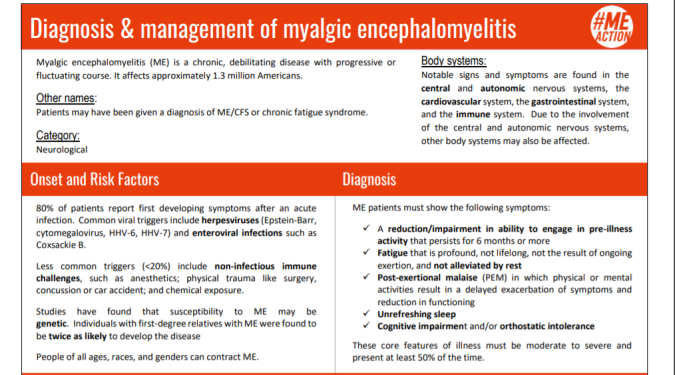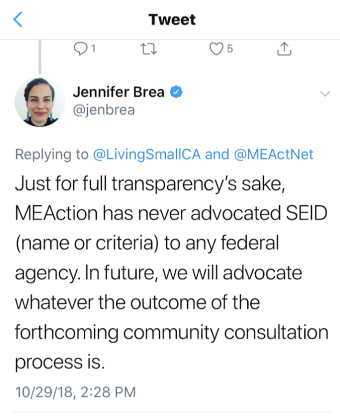
I wish to thank advocate Eileen Holderman for her consultation with this blog post.
In 2012, The U.S. Centers for Disease Control and Prevention (CDC) instituted the “ME/CFS Stakeholder Engagement and Communication conference calls (SEC)” (previously called PCOCA) series with the stated purpose of sharing information with those interested in ME/CFS as part of their regular outreach and communications efforts. These calls are billed as a form of engagement with the community, but this is just by name – not reality.
CDC’s Phantom Engagement
CDC’s claims of transparency and stated desire to engage with the ME/CFS community is debunked by their consistent underhanded actions. Their “engagement” call is, in fact, an hour-long one-sided communication. CDC placed all callers – a group of very sick disabled people – in a silent mode for the hour-long call. CDC falsely alleged they can’t take live calls when many large government events take live questions all the time.
CDC’s 60-minute call devoted 50 minutes to their invited speakers – leaving only a couple of minutes in the end to cover the many crucial questions sent in by ME patients and advocates. CDC kept us in the dark as to whose questions they selected – never giving us the actual names.
CDC refuses to make the recordings available on their website, even though they tell us that they are being recorded. CDC is very well aware that this is a community of people who are severely sick and it is too taxing for them to listen in at the appointed time and for a full hour-long call.
Conclusions about CDC’s lack of engagement and consideration of people with ME:
- CDC stages the call so that they are in complete control of the narrative
- CDC manipulates the timing of the call as to leave minimal time for public questions
- CDC refuses to take live calls because they are apprehensive of challenging questions
- CDC is more concerned about the perception of engagement than an actual one
- CDC is not worried about federal rules that call for accommodations for the disabled
- CDC does not want a record of the meeting because they want to avoid activists’ criticism
November 2, 2017, CDC Call
The latest CDC call took place on November 2, 2017. The topic was:“Take Home Messages from the 2015 Institute of Medicine Report on ME/CFS” with Drs. Lucinda Bateman, Ellen Clayton, and Peter Rowe. All three speakers served on the IOM panel to create new government-sponsored criteria and a new name – systemic exertion intolerance disease (SEID).
Background of the HHS/IOM Implementation and Stakeholders’ Protests
October 2012
In October 2012, the Chronic Fatigue Syndrome Advisory Committee (CFSAC) sent the following recommendation to Dr. Sebelius, the Secretary of The US Department of Health and Human Services (HHS): “CFSAC recommends that you will promptly convene (by 12/31/12 or as soon as possible thereafter) at least one stakeholders’ (Myalgic Encephalomyelitis (ME)/Chronic Fatigue Syndrome (CFS)experts, patients, advocates) workshop in consultation with CFSAC members to reach a consensus for a case definition useful for research, diagnosis and treatment of ME/CFS beginning with the 2003 Canadian Consensus Definition for discussion purposes.”
HHS highjacked and distorted CFSAC’s recommendation, turning their backs on their own advisory committee of experts. In Septemeber 2013, HHS secretly contracted, sponsored and charged the Institute of Medicine (IOM) to create yet again, another government-controlled clinical definition and a new name for the disease. Myalgic Encephalomyelitis (ME) stakeholders were outraged at HHS’ deception and exploitation. Fifty International ME researchers and clinicians wrote an open letter to Secretary Sebelius urging her to stop the IOM contract and to adopt the 2003 Canadian Consensus Criteria (CCC) for clinical and research purposes. Sixty six ME advocates worldwide signed a letter in support of the Experts’ Letter. ME patients sent letters to their congressional representatives with the same message – stop the IOM, adopt the CCC.
But, HHS continued to disregard the voice of the international ME community and ignored the continued protests taking place such as a new letter dated December 2013 signed by 197 professionals and advocates with detailed objections to the IOM process. Advocates also continued their protests in the form of public testimonies at the IOM January 13, 2014, open meeting (see article here).
In February 2015, the IOM panel published their report including new clinical criteria and a new name – systemic exertion intolerance disease (SEID). The new criteria have been heavily criticized by CFSAC, experts, advocates, and patients for:
- no list of exclusions
- no objective tests and measures
- not including exhaustion of the central nervous system after minor physical activity
- omitting core symptoms such as pain and immune dysfunction
- the core symptom of cognitive dysfunction is only listed as an option.
- signs of the infectious nature of the disease such as flu-like symptoms, sore throat, swollen lymph nodes and headaches are absent
- no autonomic and neuroendocrine symptoms
- no specificity toward different stages and levels of the disease
In the preface to the ICC, its authors state: “There is a poignant need to untangle the web of confusion caused by mixing diverse and often overly inclusive patient populations in one heterogeneous, multi-rubric pot called ‘chronic fatigue syndrome’. We believe this is the foremost cause of diluted and inconsistent research findings, which hinders progress, fosters skepticism, and wastes limited research monies.”
The new IOM clinical criteria are just another in the string of CDC vague, overly inclusive criteria which have and will continue to confuse and hinder progress in the science and understanding of ME. In Dr. Leonard Jason’s estimation, the IOM criteria are even broader than the previous CDC criteria – the Fukuda definition.
Alarmingly, the new clinical criteria are now being recommended and used for research. Dr. Bateman, who served on the IOM panel to create the new vague clinical criteria, has stated she will be using the IOM definition in her studies at the new NIH ME/CFS Collaborative Research Centers – disregarding the false promise that it will only be used for diagnostic purposes – never for research!
Pushing and Defending the IOM Criteria
Dr. Lee, the previous DFO of CFSAC, stated at one of their meetings – ‘it is not the job of the government to create definitions for diseases, it has to come from the community of experts.’ Yet, since the 1980’s the CDC has perpetually ignored the name and criteria authored by experts and has produced one faulty definition after another (Holmes, Fukuda, Fukuda, and IOM).
ME experts have developed and have successfully been using the CCC and the International Consensus Criteria (ICC) for years in clinical practice and for research. It is the government who has repeatedly refused to do so – opting instead to use their own faulty CDC definitions.
CDC refuses to adopt the ME experts’ definitions citing that it is too hard for clinicians to understand. Ironically, Dr. Bateman defended the weaker IOM definition with its 280-page report! She advised clinicians to look at selected chapters of the report to find what should have been part of the core symptoms of the disease. In reality, reinforcing the fact that the new criteria are inadequate and impractical.
CDC’s patient engagement call was an epic fail. It was a long infomercial for the faulty CDC/IOM criteria. It was a farce as far as engagement is concerned – there was none! They refrained from making accommodations to a community of disabled and cognitively challenged people. They falsely claimed they could not take live questions. They spent a few minutes, in the end, answering four questions for which the origin is unknown.
CDC did not answer these questions – among many others:
Question for Dr. Bateman – from Gabby Klein
You were an author of the 2011 International Consensus Criteria (ICC) which recommended removing CFS from ME. The ICC states the following: “Not only is it common sense to extricate ME patients from the assortment of conditions assembled under the CFS umbrella, it is compliant with the WHO classification rule that a disease cannot be classified under more than one rubric”.
You were an author of the IOM criteria as well which stated regarding coding: “A new code should be assigned to this disorder in the International Classification of Diseases, Tenth Revision (ICD-10), that is not linked to “chronic fatigue” or “neurasthenia.”
Since the IOM report did not ask to replace the WHO classification of ME, do you, therefore, agree that the IOM criteria do not define the disease Myalgic Encephalomyelitis (ME)?
Question for Dr. Bateman – from Colleen Steckel
The IOM panel was charged by its sponsor, HHS, to ”recommend clinical diagnostic criteria that would address the needs of healthcare providers, patients, and their caregivers.” In addition, in an interview with Phoenix Rising regarding the IOM criteria, Dr. Bateman stated: “SEID criteria are intended for current use, for doctors to do better at making the diagnosis in a clinical setting. There was no discussion of anything but using them for this purpose.”
Yet, NIH is currently recommending the use of the IOM criteria for their new ME/CFS (myalgic encephalomyelitis/chronic fatigue syndrome) competitive consortium grants. Can you explain why new clinical criteria will now be used for research?
The expert criteria ICC would ensure the disease myalgic encephalomyelitis would be the focus of any studies.
Question for Dr. Unger – from Colleen Steckel
Are there any plans to address the concerns raised by MEadvocacy.org in their recent blog labeled “CDC’s Website Revision is No Reason for Celebration”?
Patients continue to be told by doctors that this is just a fatigue illness and refuse to look into immunological, cardiology, and neurological issues. Patients continue to fend for themselves with little care from mainstream doctors. This continues to lead to despair and suicide within the community. The CDC needs to do much more in order to change this reality.
Questions to Dr. Unger – from Eileen Holderman
What are the official case definitions for ME that CDC endorses for research and clinical?
As former CFSAC member and Chair of Subcommittee for CDC Website Review, when will CDC take down Toolkit and Resource Guide from the CDC website Stacks?
Questions from Guido Den Broeder
(1) Will you please once more distinguish between ME and CFS, as you did before?
Myalgic encephalomyelitis (at G93.3 in the ICD-10) is a specific post-viral brain disorder. Much is known about its causes, diagnostics, and treatment.
Chronic Fatigue Syndrome (R53.82 in the ICD-10-CM) is a term for unexplained fatigue and malaise. It is not a disease. In clinical practice, patients with a variety of diseases start out with a diagnosis of CFS, even though this is not a clinical diagnosis.
(2) What are you going to do to prevent ME?
Will Coxsackie B be added to polio vaccinations?
Are you going to follow mononucleosis patients and test their immune system for post-mono abnormalities?
(3) What are you going to do to reduce the clinical use of the CFS label?
Will you increase awareness among physicians of diseases such as ME, EDS, Lyme, Hashimoto, etc.?
Are you going to promote the clinical use of the SEID label as defined by the IOM?
These are only some of the many questions from patients and advocates that CDC has not answered!












